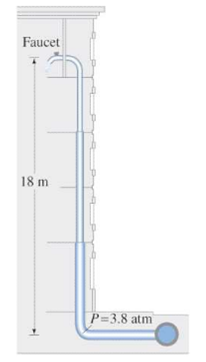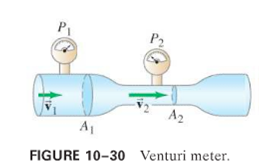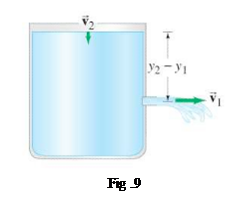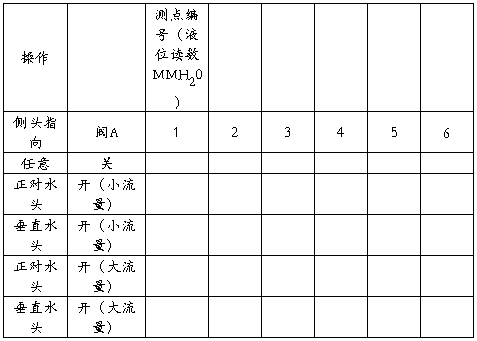AP 物理 B- 《伯努利方程》
Bernoulli’s equation
1Show that Bernoulli’s equation reduces to the hydrostatic variation of pressure with depth when there is no flow(v1=v2=0)
2 How fast does water flow from a hole at the bottom of a very wide , 4.6-m-deep storage tank filled with water ? Ignore viscosity .
3 A large pipe with a cross-sectional area of 1.00 m2 descends 5.00 m and narrows to 0.500 m2, where it terminates in a valve at point 1. If the pressure at point 2 is atmospheric pressure, and the valve is opened wide and water allowed to flow freely, find the speed of the water leaving the pipe.

4 An airplane has wings, each with area 4.00 m2, designed so that air flows over the top of the wing at 245 m/s and underneath the wing at 222 m/s. Find the mass of the airplane such that the lift on the plane will support its weight, assuming the force from the pressure difference across the wings is directed straight upward.(The density of air  )
)
5 A 6.0-cm-diameter horizontal pipe gradully narrows to 4.0cm . When water flows through this pipe at a certain rate , the gauge pressure in these two sections is 32.0 kPa and 24.0 kPa ,respectively . What is the volume rate of flow ?
6 Estimate the air pressure inside a category 5 hurricane ,where the wind speed in 300 km/h .

 7 Water at a gauge pressure of 3.8 atm at street level flows into an office building at a speed of 0.60 m/s through a pipe 5.0 cm in diameter . The pipe tapers down to 2.6 cm in diameter by the top floor , 18 m above , where the faucet has been left open . Calculate the flow velocity and the gauge pressure in such a pipe on the top floor . Assume no branch pipes and ignore viscosity .
7 Water at a gauge pressure of 3.8 atm at street level flows into an office building at a speed of 0.60 m/s through a pipe 5.0 cm in diameter . The pipe tapers down to 2.6 cm in diameter by the top floor , 18 m above , where the faucet has been left open . Calculate the flow velocity and the gauge pressure in such a pipe on the top floor . Assume no branch pipes and ignore viscosity .
8 (a) Show that the flow velocity measured by venturi meter is given by the relation

(b) A venturi tube is measuring the flow of water , it has a main diameter of 3.0 cm tapering down to a throat diameter of 1.0 cm , if the pressure difference is measured to be 18mm-Hg , what is the velocity of the water ?

9 In Fig. 9 , take into accout the speed of the top surface of the tank and show that the speed of fluid leaving the opening at the bottom is
 ,
,
Where  , and A1 and A2 are the areas of the opening and of the top surface ,respectively .Assume
, and A1 and A2 are the areas of the opening and of the top surface ,respectively .Assume  so that the flow remains nearly steady and laminar .
so that the flow remains nearly steady and laminar .

10 Suppose the opening in the tank of Fig. 9 is a height h1 above the base and liquid surface is a height h2 above the base . The tank rests on level ground . (a) At what horizontal distance from the base strike the ground ? (b) At what other height , h1’ , can a hole be placed so that the emerging liquid will have the same ‘range’ ? Assume 
第二篇:伯努利方程实验
实验一 伯努利方程实验
一、实验目的
(1)了解在不同情况下,流动流体中各种能量间相互转换关系和规律,加深对伯努利方程的理解;
(2)观测流动流体阻力的表现。
二、实验原理
(1)流体在流动中具有三种机械能,即位能、动能、静压能,这三种能量是可以相互转换的,当管路条件改变时(如位置、高低、管径、大小),它们便发生能量转换;
(2)对于理想流体,因为不存在因摩擦而产生的机械能损失,因此,在同一管路中的任何两个截面上的三种机械能尽管彼此不一定相等,但各截面上的这三种机械能的和总是相等的;
(3)对于实际流体,在流动过程中有一部分机械能因摩擦和碰撞而损失(不能恢复),转化为热能,因此各截面上的机械能总和是不相等的,两者的差就是流体在这两截面之间因摩擦和湍动转化为热能的机械能,即损失能量;
(4)流体的机械能衡算,以单位质量(1kg)流体为衡算基准,当流体在两截面之间稳定流动且无外功加入时,伯努利方程的表达形式为
 式中
式中
z —— 位压头(m流体柱);
 —— 静压头(m流体柱);
—— 静压头(m流体柱);
 —— 动压头(m流体柱)。
—— 动压头(m流体柱)。
三、实验设备及流程
1. 实验装置流程
如图3-1所示,实验设备由玻璃管、测压管、活动测压头、水槽、循环水泵等组成。水槽中的水通过循环水泵将水送到高位槽,并由溢流口保持一定水位,然后流经玻璃管中的各测点,再通过出口阀A流回水箱,由此利用循环水在管路中流动观察流体流动时发生能量转化及产生能量损失。
活动测压头的小管端部封闭,管身开有小孔,小孔位置与玻璃管中心线平齐,小管又与测压管相通,转动活动测压头就可以测量动、静压头。管路分成四段,由大小不同的两种规格的玻璃管组成。
2. 测压管
当测压管上的小孔与水流方向垂直时,测压管内液位高度(从测压孔中心线算起)即为静压头,它反映测压点处液体的压强大小;当测压孔转为正对水流方向时,测压管内液位上升,所增加的液位高度即为测压孔处流体的动压头,它反映出该点水流动能的大小,这时测压管内液位高度为静压头+动压头。
液体的位压头由测压孔到基准的高度决定。本实验装置中,以测压装置中标尺的零点处为基准面,那么,
(1)中测压管内液位高度在标尺上的读数为:静压头+位压头;
(2)中测压管内液位高度在标尺上的读数为:静压头+动压头+位压头,任意两截面上,位压头、静压头、动压头三者总和之差为损失压头,表示流体流经截面之间的机械能损失。
四、实验步骤
1. 步骤
(1)实验前观察了解实验装置(循环泵的开、关,溢流管控制高位槽液面,出口阀A调节流量,活动弯头的转动,活动测头结构以及测压管标尺的基准等)。开动循环水泵,同时注意高位槽中液面是否稳定。
(2)观察玻璃管中有无气泡,若有气泡,可先开循环水泵,再开大出口阀让水流带出气泡,也可用拇指按住管的出口,然后突然放开,如此按数次使水流带出气泡,也可拧松活动测压头密封的压盖,以便放出测压点处的气泡。
(3)关闭出口阀A,开动循环水泵,待高位槽中液面稳定以后,观察并记录各测压管液面高度(侧压孔同时正对或同时垂直水流方向,两组数据),见表3—1。
表3—1 各测压点的各项压头

(4)略打开出口阀A,(小流量)使测压孔同时平行(正对)水流方向,测取各侧压管液面高度,同时用活动弯头测取流量(即测定流出1000mL水所需时间),见表3—2。
表3—2 流速测点

(5)开大出口阀A,使小孔方向同时正对或同时垂直水流方向测取两组数据,同时测取流量。
(6)实验结束,关闭出口阀A,关闭循环水泵。
2. 实验注意事项
(1)读取测压管液面高度时,眼睛要和液面水平,读取凹液面下端的值;
(2)测流量时,至少测两次,要求两次水的流出体积同为1000mL,流出时间差不超过0.2s;
(3)实验开始,先开泵,后开出口阀A;实验结束,先关出口阀A,后关水泵,以保证玻璃管中充满液体。
五、实验结果及要求
回答或计算下列问题:
(1) 关闭出口阀A时。
a. 转动测压头时,各测点液位高度有无变化?这一现象说明什么?
b. 这一高度的物理意义是什么?
(2) 小流量下,当小孔对准水流方向时,记录的各测压管液面高度。
a. 这一高度的物理意义是什么?
b. 对比表3-3中同一测压管液面高度,此高度差表示什么?离高位槽愈远,此液面高度愈( )?为什么?
(3)大流量下。
a. 当小孔对准水流方向时,流速增加,动压头应该( ),而液位高度( ),这一现象说明什么?
b. 第四测压点处的流速,大流量下比小流量下增大多少倍?
c. 计算由高位槽液面到第四测压点处损失压头在大流量下与小流量下的比值。
(4) 运用伯努利方程,确定各测压点的各项压头(以大流量下数据确定)。
(5) 运用伯努利方程解释:1点至2点,静压头、动压头的变化;3点至4点,静压头、位压头的变化。
(6) 流速测点。
(7) 计算举例。
六、思考题
(1)说明点2与点3平均流速不同的原因。
(2)说明点2的平均流速与点速度不同的原因。
七、实验数据记录参考表(见表3-3)
原始数据:
设备编号:
管内径:d1= m, d2= m, d= m;
位压头:H1=H2=H3= m, H4= m;
表3-3 实验数据记录

伯努利方程实验
一、实验目的
二、实验原理
三、实验设备
四、实验步骤
五、实验结果及要求
回答下列问题:
(1) 关闭出口阀A时。
a. 转动测压头时,各测点液位高度有无变化?这一现象说明什么?
b. 这一高度的物理意义是什么?
(2) 小流量下,当小孔对准水流方向时,记录的各测压管液面高度。
a. 这一高度的物理意义是什么?此高度差表示什么?离高位槽愈远,此液面高度愈( )?为什么?
(3)大流量下当小孔对准水流方向时,流速增加,动压头应该( ),而液位高度( ),这一现象说明什么?
(4)运用伯努利方程解释:1点至2点,静压头、动压头的变化;3点至4点,静压头、位压头的变化。
表3—1 各测压点的各项压头

六、思考题
(1)说明点2与点3平均流速不同的原因。
(2)说明点2的平均流速与点速度不同的原因。
-
伯努利方程实验报告
不可压缩流体定常流能量方程伯努利方程实验一实验目的要求1掌握流速流量压强等动水力学水力要素的实验量测技术2验证流体定常流的能量方程…
-
实验一伯努利方程实验报告 2
液压传动实验报告姓名陈国庆学号0806110902班级机械1107班2实验一伯努利方程实验一实验目的要求1验证流体恒定流动时的总流…
-
化工实验报告-伯努利方程式实验
太原师范学院实验报告ExperimentationReportofTaiyuanteachersCollege系部化学系年级大四课…
-
伯努利方程实验实验报告
伯努利方程实验一实验目的1通过实验加深对伯努利方程式及能量之间转换的了解2观察水流沿程的能量变化并了解其几何意义3了解压头损失大小…
-
伯努利方程实验报告
不可压缩流体定常流能量方程伯努利方程实验一实验目的要求1掌握流速流量压强等动水力学水力要素的实验量测技术2验证流体定常流的能量方程…
-
20xx年AP物理B考试综合评析及20xx年AP物理1&2展望
20xxAP物理B考试综合评析与20xxAP物理1amp2考试展望北京新东方北美美本本地APampSATII项目王雨辰20xx年5…
-
AP物理考试分析
AP物理考试分析360教育集团介绍20xx年AP物理考试是改革前的最后一次考试也是不少中国考生今年的最后一门考试根据大家各自的回忆…
-
AP物理1和AP物理2考试必备知识点
20xx年5月AP物理B考试完成了它的使命就此退出历史舞台20xx年这门考试将被两门全新的考试所取代分别为AP物理1和AP物理2虽…
-
AP物理课程考试
AP物理课程考试据360教育集团介绍AP物理课程都考什么AP物理课程共有三门分别是物理B物理C力学和C电磁学据360教育集团介绍有…
-
学习AP物理的原因
标题学习AP物理的原因物理作为基础学科是大学里理科和工科绝大多数专业的必修课同时根据文科和商科学生选修课的理科学科Science要…